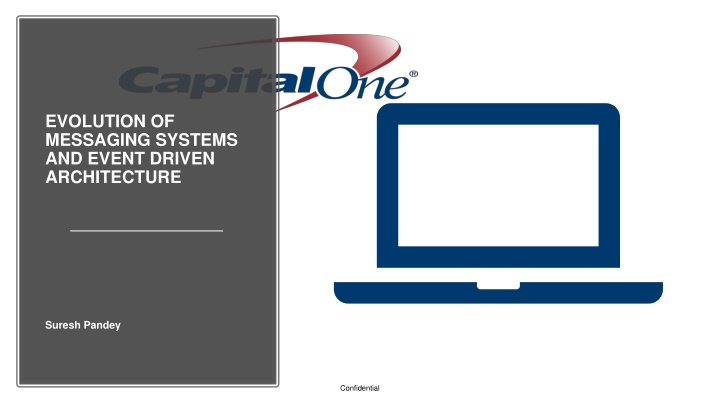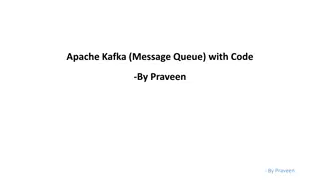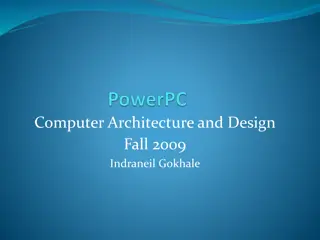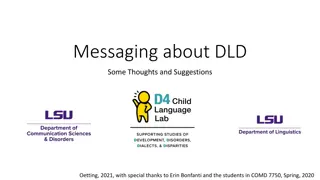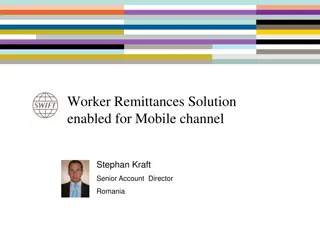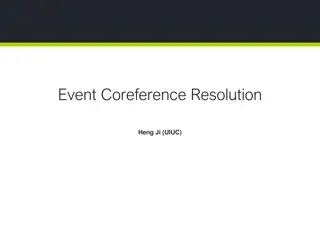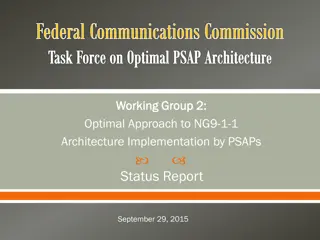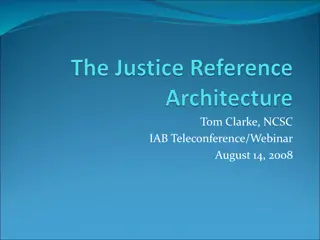Evolution of Messaging Systems and Event-Driven Architecture
This content discusses the evolution of messaging systems and event-driven architecture, covering topics such as Java Messaging System, RabbitMQ, Kafka architecture, Kinesis, and asynchronous mode of communication. It also explores the challenges and advantages of different messaging protocols and architectures in modern systems integration.
Download Presentation

Please find below an Image/Link to download the presentation.
The content on the website is provided AS IS for your information and personal use only. It may not be sold, licensed, or shared on other websites without obtaining consent from the author.If you encounter any issues during the download, it is possible that the publisher has removed the file from their server.
You are allowed to download the files provided on this website for personal or commercial use, subject to the condition that they are used lawfully. All files are the property of their respective owners.
The content on the website is provided AS IS for your information and personal use only. It may not be sold, licensed, or shared on other websites without obtaining consent from the author.
E N D
Presentation Transcript
EVOLUTION OF MESSAGING SYSTEMS AND EVENT DRIVEN ARCHITECTURE Suresh Pandey Confidential
Messaging Overview Java Messaging System Advanced Messaging Queuing Protocol RabbitMQ architecture Evolution of Kafka Kafka Architecture and Design Scalability and Performance Kinesis Overview Kinesis vs. Kafka Sources Topics to Cover Confidential 2
Asynchronous mode of communication. Sender & Receiver interact through message broker. Messages in queue stored until the recipient retrieves them. Messaging overview Implicit or Explicit Limits on size of data transmitted in a single message and the number of messages that may remain outstanding on the queue. Point to point system without messaging Loan Processor Credit Policy Underwriting Funding Confidential 3
Loan Processor sub-prime Loan Processor prime Adding new system requires p2p connection with all existing systems Credit Policy Underwriting Funding Error prone and difficult to integrate with new systems Loan Processor Prime Loan Processor Sub-Prime Easier to integrate new systems by using BUS architecture Less connection to be maintained by each application Credit Policy Underwriting Funding Asynchronous processing Confidential 4
Java Message Producer JMS API Java Messaging System (JMS) OpenWire ActiveMQ OpenWire JMS API Java Message Service (JMS) is an application program interface (API) specs from Sun Microsystems Java Message Consumer Confidential 5
Java Message Producer JMS API Java Messaging System (JMS) OpenWire ActiveMQ A limitation of JMS is that the APIs are specified, but the message format is not JMS has no requirement for how messages are formed and transmitted. Essentially, every JMS broker can implement the messages in a different format. They just have to use the same API OpenWire JMS API Java Message Service (JMS) is an application program interface (API) specs from Sun Microsystems Java Message Consumer Confidential 6
Java Message Producer JMS API Java Messaging System (JMS) OpenWire ActiveMQ STOMP Ruby can t use JMS , you need a message broker that can bridge the two platforms and transform the protocol and message structure used by each platform Supports both STOMP and JMS simultaneously ActiveMQ contains built-in message bridge for JMS to STOMP and vice versa conversion STOMP CLIENT Ruby Message Consumer Confidential 7
Java Message Producer RabbitMQ Client Advanced Message Queuing Protocol (AMQP) AMQP AMQP Broker RabbitMQ AMQP Solve the problem of messaging interoperability between heterogeneous platforms by defining standard binary level protocol. Qpid client By defining a wire-level protocol standard for messaging , AMQP creates a message-based interoperability model that is completely client API or server (message broker) agnostic Ruby Message Consumer As long as you are using AMQP you can connect and send messages to any AMQP message broker using any AMQP client Confidential 8
Traditional architecture Single Point of Failure Server1 Consumer 1 Highly Available Server2 LOAD BALANCER PRODUCER Scalable Server3 Consumer 2 Server4 Performance Confidential 9
RabbitMQ AMQP Producer Widely deployed open source message broker based on AMQP N1 N2 N3 Distributed broker, provide cluster for load balancing. High Availability(HA) mode by mirroring queues. AMQP Consumer Supports fully transactional communication between clients and brokers using acknowledgements. Great support in Spring framework. Confidential 10
RabbitMQ Architecture 1 2 3 4 Smart broker / dumb consumer model Publishers send messages to exchanges, and consumers retrieve messages from queues RabbitMQ cluster distributes queues for the Read/Write load distribution. High Availability(HA) mode by mirroring queues. Confidential 11
Q1 Master Single point of failure Q2 Mirrored EXCHANGE Q3 Mirrored Node 1 Highly Available Q2 Master Producer LB Q1 Mirrored Consumer EXCHANGE Q3 Mirrored Node 2 Scalable Q3 Master Q1 Mirrored Performance EXCHANGE Q2 Mirrored Node 3 Confidential 12
Kafka Producer: Application that sends the messages. Consumer: Application that receives the messages. Topic: A Topic is a category/feed name to which messages are stored and published. Topic partition: Kafka topics are divided into a number of partitions. Partitions allow you to parallelize a topic by splitting the data in a Kafka particular topic across multiple brokers. Replicas A replica of a partition is a "backup" of a partition. Replicas never read or write data. They are used to prevent data loss. Consumer Group: A consumer group includes the set of consumer processes that are subscribing to a specific topic. Offset: The offset is a unique identifier of a record within a partition. It denotes the position of the consumer in the partition. Cluster: A cluster is a group of nodes i.e., a group of computers. Confidential 13
Kafka employs a dumb broker smart consumers model. Kafka broker does not attempt to track which messages were read by each consumer. Kafka retains all messages for a set amount of time, and consumers are responsible to track their location in each log Confidential 14
Kafka Message Log For each topic, the Kafka cluster maintains a partitioned log Partition 0 0 1 2 3 4 5 6 7 8 9 10 11 12 Partition 1 0 1 2 3 4 5 6 7 8 9 WRITES Partition 2 0 1 2 3 4 5 6 7 8 9 10 11 Partition 3 0 1 2 3 4 5 6 7 8 Older Newer Confidential 15
Topic A, Partition 0 Topic A, Partition 1 Topic B, Partition 1 Consumer Group X Consumer : Topic A Producer 1 Consumer Groups Node 1 Topic B, Partition 0 Consumer Group Y Consumer : Topic B Producer 2 Topic A, Partition 2 Topic B, Partition 2 Node 2 Confidential 16
Topic A, Partition 0 Topic A, Partition 1 Consumer : Topic A Topic B, Partition 1 Consumer Group X Producer 1 Consumer : Topic A Node 1 Rebalancing Consumer Groups Topic B, Partition 0 Consumer : Topic B Producer 2 Topic A, Partition 2 Consumer Group Y Topic B, Partition 2 Consumer : Topic B Node 2 Consumer : Topic B Confidential 17
Consumer Group Z Consumer : Topic A Topic A, Partition 0 Topic A, Partition 1 Consumer : Topic A Topic B, Partition 1 Consumer Group X Producer 1 Rebalancing Consumer Groups Consumer : Topic A Node 1 Topic B, Partition 0 Consumer : Topic B Producer 2 Topic A, Partition 2 Consumer Group Y Topic B, Partition 2 Consumer : Topic B Node 2 Consumer : Topic B Confidential 18
Managing Zookeeper Managing Apache Kafka Monitoring Apache Zookeeper node failures Monitoring Apache Kafka Brokers failures Monitoring Disk, CPU and Memory) Managing Kafka Cluster Monitoring Disk, CPU and Memory Monitoring partition throughput Apache Zookeeper JVM Tuning Migrating Apache Kafka partitions to new nodes to increase throughput Scaling Zookeeper nodes to increase CPU, Memory and Disk resources Upgrading Zookeeper version Upgrading Apache Kafka version Multi-AZ deployment Failing over to a different cluster in a different data-center or availability-zone Multi-AZ deployment Confidential 19
Kinesis Kafka Kinesis Fully-managed streaming processing service available on Amazon Web Services (AWS). Topic Stream Partition Shard Easily scalable to match data volume using apis. Broker N/A Data replication across 3 AZs Kafka Producer Kinesis Producer Kafka Consumer Kinesis Consumer Integrated with other AWS services Offset Sequence Number Replication Not required Confidential 20
Depends on the number of CPU cores, memory, and the performance of the local disks. Scalability: Kafka To increase the throughput of the system having more partition than nodes, the users have to add more hardware capacity to the cluster and migrate the existing partitions to the newly added resources. To increase the throughput of the cluster having node equals to partition, one has to add more resources to the existing resources, also known as scaling up. Apache Kafka holds historical data, users may be required to increase the disk footprint capacity of the cluster. Confidential 21
Scalability: Kinesis Throughput of each Shard is pre-advertised. 1000 PUT records-per sec or 1MBps of write. 2Mbps or 5-transactions per-sec of read traffic. In order to increase the throughput of a given Amazon Kinesis stream, more Shards can be added using apis or using AWS console. The benefit of the Amazon Kinesis throughput model is that the users have a prior knowledge of the exact performance numbers to expect for every provisioned Shard. Current read limit of 5 transaction-per second limits on how many applications can read from one shard at any given time. Confidential 22
Kinesis Latency in the range of 1-5 seconds. Applications that require < 1-second latency are not an ideal use-case for Amazon Kinesis. Latency Kafka Configured to perform < 1second Durability Kafka Provides durability by replicating data to multiple broker nodes Kinesis Provides the same durability guarantees by replicating the data to multiple availability zones. Delivery Semantics Both Apache Kafka and Amazon Kinesis provide at-least-once delivery semantic. Confidential 23
Managing Kafka Managing Kinesis Monitoring Apache Kafka Brokers failures N/A handled by Kinesis Service Monitoring Disk, CPU and Memory) N/A handled by Kinesis Service Migrating Apache Kafka partitions to new nodes to increase throughput Amazon Kinesis API to add & remove Shard Kafka vs Kinesis: Cost Factor Tuning Apache Kafka JVM settings N/A handled by Kinesis Service Scaling Brokers to increase CPU, Memory and Disk resources N/A handled by Kinesis Service Upgrading Apache Kafka version N/A handled by Kinesis Service Recovering/Replacing failed Brokers N/A handled by Kinesis Service Failing over to a different cluster in a different data-center or availability-zone N/A handled by Kinesis Service Multi-AZ deployment N/A handled by Kinesis Service Confidential 24
Sources http://www.wmrichards.com/amqp.pdf http://go.datapipe.com/whitepaper-kafka-vs-kinesis-download http://docs.aws.amazon.com/streams/latest/dev/key-concepts.html https://aws.amazon.com/kinesis/streams/faqs/ Confidential 25
